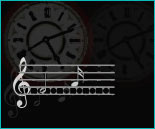Rhythm is one of the three building blocks of music theory. Without it, timing wouldn’t exist- much like the basic tablature system lacks timing and rhythm. For music theorists who take the time to learn the three building blocks of music theory- rhythm, harmony, and melody; the payout will be enormous in the long run.

To start off, every song is divided into measures. Measures are small segments separated by bar lines, or vertical slashes. Different types of bar lines mean different things. A single vertical slash simply means the measure is complete, while a double bar line indicaes the section of measures is at an end. Lastly, a terminal bar line indicates the end of a piece of music.

Measures are composed of beats, or counts per measure. Right next to the treble clef is a pair of numbers, which looks like a fraction. The most common is 4/4 time, which simply means there are 4 beats per measure, and each quarter note is a whole beat. This is also seen sparingly as the capital C, which means common time, or 4/4 time. Other timing signatures that are less common may be somewhat harder to play. Essentially, the top number determinesthe beats per measure, and the bottom number indicates the type of note receiving each beat. ¾ timing is defined by 3 beats per measure, with Quarter notes receiving each beat. Likewise, a 6/8 time signature means that each measure is 6 beats, and that the Eighth note receives each beat.

A guitar player will notice that each bottom number can indicate a different duration- but do not be discouraged there are only 5 basic durations to remember. A Whole note is 4 beats, a Half note is 2 beats, a Quarter note is 1 beat, an Eighth note is ½ a beat, and a Sixteenth note is ¼ of a beat. Notice that each step, the timing is halved. This makes learning the systm very easy. Practicing each note with a metronome will give a guitar player the skills necessary to play each note’s duration correctly. In 4/4 time, 4 quarter notes will each take a second to play- this is a nice exercise to practice to get perfect timing.

Of course, guitar players won’t always be pumping out notes and sounds- rests are needed too. The common 5 rests are just like the common note durations, only with different symbols. One thing that can complicate things is the dotted note. A dot placed immediately after the note head increases the duration of th note or rest by one half. Why complicate things? The answer lies in accurate timing. If every note was 1, 2, or 4 beats long, there would be nothing in between each note’s duration. A note with a duration of 3 beats may be needed- and to get this, you add a Half note with a dot (2 beats + one half of two beats = 3 beats).

Ever wonder why some groups of notes have big black beams across them? This is to make reading music much more legible. For instance, say that eight ¼ notes were in succession with each other. It would be tough reading each note, while playing, and keeping track of which note you were on, wouldn’t it? Thi is why notes that are alike or similar are grouped together. These same eight ½ notes can be combines into a group of 4 beamed notes. This can also be done with similar notes, such as one Quarter note and two Eighth notes.

At the end of this lesson, it’s time to bust out the metronome and get to work. Practice timing until it comes as second nature to tell the difference between a whole note and half note is. When timing is perfected, a piece of sheet music can be gazed at, and recreating the song’s exact timing should be no trouble at all. If timing isn’t a strong point in a guitar player’s qualities, then a good metronome will do a world of good.

It’s really important to verbalise rhythm.
After all, it’s a language, right?
When I think of all the rehearsals I have been at I have only heard people verbalise their ideas.
“Like dude! It goes: wop wop wop a walawala boom waka shoooo!” as an example.
I’ve never heard anyone sing 1 + 2 + 3e+a 4 + at any rehearsal.
I’ve heard 1 + 2 + 3e+a 4 + in the classroom but never on the bandstand.
Which made me think real hard about rhythm verbalising.
This is a good place to see some of the fruits of that hard thinking.
Great that you’re talking about rhythm. Thanks for your article.